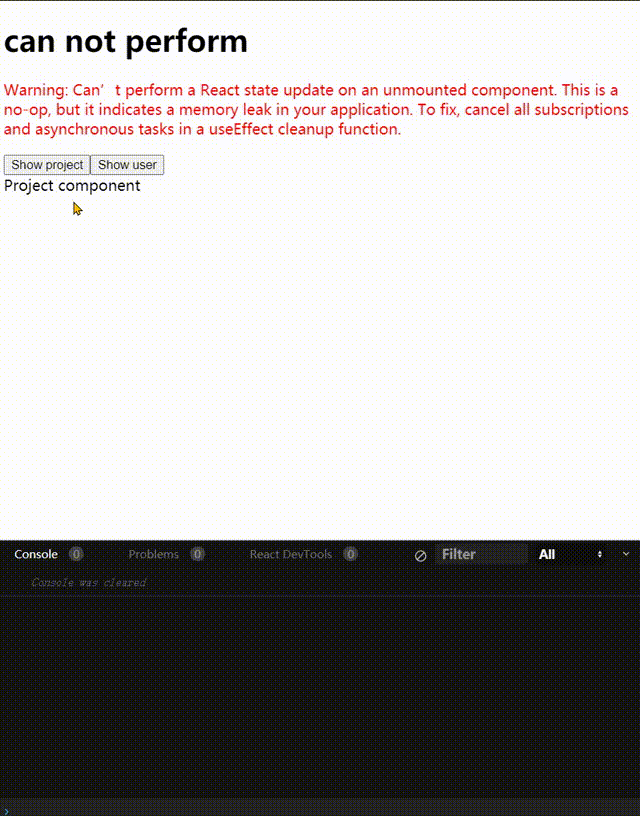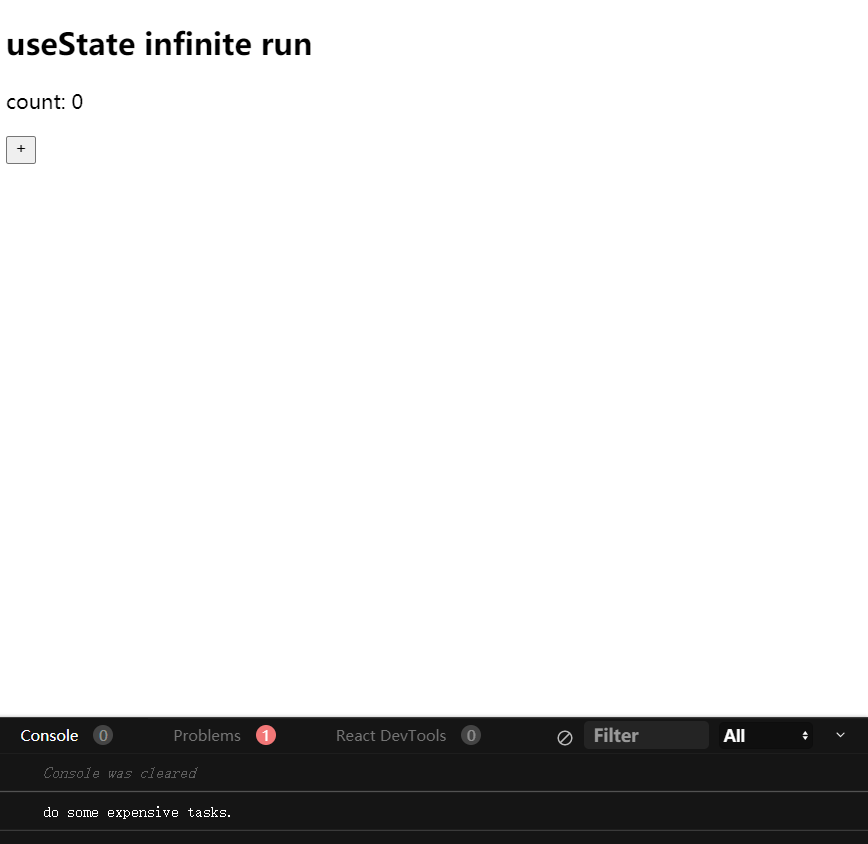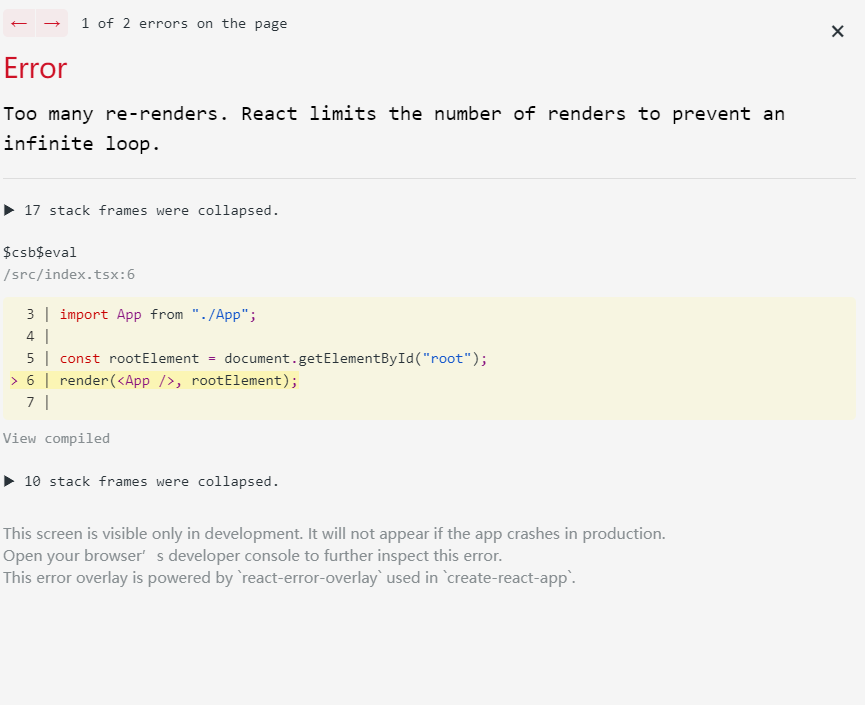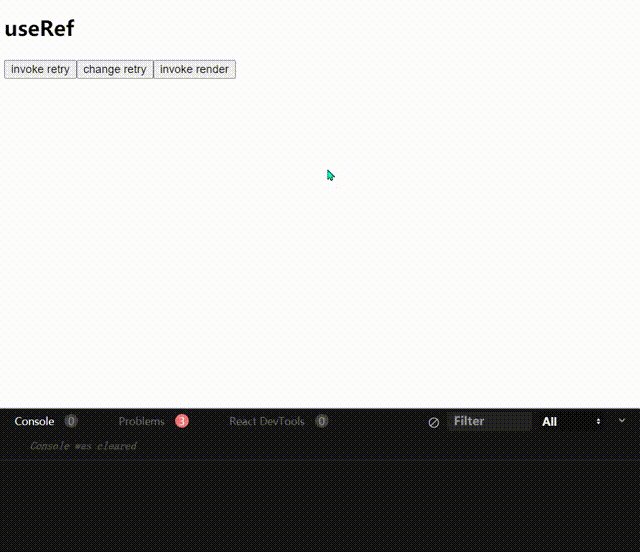react - 踩坑经历
# Can’t perform a React state...
# 问题描述
在学习 React17+React Hook+TS4 最佳实践仿 Jira 企业级项目 (opens new window) 中遇到一个警告:
Warning: Can’t perform a React state update on an unmounted component. This is a no-op, but it indicates a memory leak in your application. To fix, cancel all subscriptions and asynchronous tasks in a useEffect cleanup function.
显然,这是因为在组件卸载的时候,继续使用了 setState 方法,可能会导致内存泄露。
但是,项目开发在一半,项目的复杂性已经上来了,而且控制台的提示太模棱两可了, bug 非常难以定位。
从其他开发者的博客中可以了解到,该问题是在组件卸载的时候,setState 可能会执行导致内存泄漏。
主要原因如下:
- 在
setTimeout使用了 setState,但却没有在组件卸载之前清楚定时器。 - 在
Promise.then中使用了setState后,没有及时清理副作用,等到下一轮任务来临时, React 组件可能已经被卸载了。
# 问题重现
import { useEffect, useState } from 'react'
const User = () => {
const [user, setUser] = useState<{ id: number; name: string } | null>(null)
useEffect(() => {
setTimeout(() => {
// The warning is generated by this code
// If the component unmounts faster than 3s
setUser({
id: 1,
name: 'John',
})
}, 3000)
}, [])
return <div>{user?.name || 'No user found'}</div>
}
const Project = () => <div>Project component</div>
const CanNotPerformExample1 = () => {
const [activeView, setActiveView] = useState('project')
const toggleUser = () => {
setActiveView('user')
}
const toggleProject = () => {
setActiveView('project')
}
return (
<div>
<button onClick={toggleProject}>Show project</button>
<button onClick={toggleUser}>Show user</button>
{activeView === 'user' ? <User /> : <Project />}
</div>
)
}
export const CanNotPerformExample = () => {
return (
<div>
<div className='desc'>
<h1>can not perform</h1>
<p style={{ color: 'red' }}>
Warning: Can’t perform a React state update on an unmounted
component. This is a no-op, but it indicates a memory leak in your
application. To fix, cancel all subscriptions and asynchronous tasks
in a useEffect cleanup function.
</p>
</div>
<div className='examples'>
<CanNotPerformExample1 />
</div>
</div>
)
}
2
3
4
5
6
7
8
9
10
11
12
13
14
15
16
17
18
19
20
21
22
23
24
25
26
27
28
29
30
31
32
33
34
35
36
37
38
39
40
41
42
43
44
45
46
47
48
49
50
51
52
53
54
55
56
57

在这个案例中,之所以会出现这个问题,是因为我们在切换组件的时候,setTimeout 中的代码还没
执行,当 <User /> 组件卸载的时候,setTimeout 中的代码才开始执行,然而 state 已经
被回收了,所以会导致内存泄漏。
# 问题解决
# 方案一:使用 useEffect cleanup
useEffect 为我们提供了 cleanup 的功能,只需要在 useEffect
的回调中返回一个 cleanup 函数即可。
const User = () => {
const [user, setUser] = useState<{ id: number; name: string } | null>(null)
useEfnect(() => {
const timer = setTimeout(() => {
// The warning is generated by this code
// If the component unmounts faster than 3s
setUser({
id: 1,
name: 'John'
})
}, 3000)
return () => {
clearTimeout(timer)
}
}, [])
2
3
4
5
6
7
8
9
10
11
12
13
14
15
16
# 方案二:使用一个标识位
事实上,除了 setTimeout 这类定时器会触发这个警告之外,像 Promise.then 这类微任务也可能
触发这个警告。Promise 一旦承若就会执行,所以我们需要一个标识位来避免执行。
//* Solution2
useEffect(() => {
let isMounted = true
setTimeout(() => {
// The warning is generated by this code
// If the component unmounts faster than 3s
if (isMounted) {
setUser({
id: 1,
name: 'John',
})
}
}, 3000)
return () => {
isMounted = false
}
}, [])
2
3
4
5
6
7
8
9
10
11
12
13
14
15
16
17
# 实际开发中的问题
import { useCallback, useState } from 'react'
export interface IState<D> {
stat: 'idle' | 'loading' | 'error' | 'success'
data: D | null
error: Error | null
}
const defaultState: IState<null> = {
stat: 'idle',
data: null,
error: null,
}
const defaultConfig = {
throwOnError: false,
}
const useAsync = <D>(
initialState?: IState<D>,
initialConfig?: typeof defaultConfig,
) => {
initialConfig = {
...defaultConfig,
...initialConfig,
}
const [state, setState] = useState<IState<D>>({
...defaultState,
...initialState,
})
const [retry, setRetry] = useState(() => () => {})
const setError = useCallback((error: Error) => {
setState({
data: null,
stat: 'error',
error,
})
}, [])
const setData = useCallback((data: D) => {
setState({
data,
error: null,
stat: 'success',
})
// return data
}, [])
const run = useCallback(
(promise: Promise<D>, runConfig?: { retry: () => Promise<D> }) => {
if (!promise || !promise.then) {
throw new Error(`${promise} should be a Promise type.`)
}
setState(prevState => ({ ...prevState, stat: 'loading' }))
setRetry(() => () => {
if (runConfig?.retry) {
run(runConfig.retry(), runConfig)
}
})
return promise
.then(data => {
setData(data)
return data
})
.catch(e => {
setError(e)
return initialConfig?.throwOnError ? Promise.reject(e) : e
// return Promise.reject(e)
})
},
[isMountedRef, initialConfig.throwOnError, setData, setError],
)
return {
isLoading: state.stat === 'loading',
isIdle: state.stat === 'idle',
isError: state.stat === 'error',
isSuccess: state.stat === 'success',
setData,
setError,
run,
retry,
...state,
}
}
export default useAsync
2
3
4
5
6
7
8
9
10
11
12
13
14
15
16
17
18
19
20
21
22
23
24
25
26
27
28
29
30
31
32
33
34
35
36
37
38
39
40
41
42
43
44
45
46
47
48
49
50
51
52
53
54
55
56
57
58
59
60
61
62
63
64
65
66
67
68
69
70
71
72
73
74
75
76
77
78
79
80
81
82
83
84
85
86
87
88
在自定义 useAsync hook 的时候就遇到在这种问题,主要原因还是在 Promise.then 和 Promise.catch
中使用了 setState 方法。
解决方法:这里需要 useEffect 的 cleanup 函数在组件卸载的时候执行清理操作。
- 使用
useRef缓存一个标识位。 - 执行 cleanup 函数的时候,重置标识位即可。
- 在使用
setState的时候,先判断是否满足要求,再决定setState。
const useMountedRef = () => {
const isMountedRef = useRef(false)
useEffect(() => {
isMountedRef.current = true
return () => {
isMountedRef.current = false
}
}, [])
return isMountedRef
}
const useAsync = <D>(
initialState?: IState<D>,
initialConfig?: typeof defaultConfig,
) => {
// statements...
const isMountedRef = useMountedRef()
const run = useCallback(
(promise: Promise<D>, runConfig?: { retry: () => Promise<D> }) => {
if (!promise || !promise.then) {
throw new Error(`${promise} should be a Promise type.`)
}
setState(prevState => ({ ...prevState, stat: 'loading' }))
setRetry(() => () => {
if (runConfig?.retry) {
run(runConfig.retry(), runConfig)
}
})
return promise
.then(data => {
isMountedRef.current && setData(data)
return data
})
.catch(e => {
isMountedRef.current && setError(e)
return initialConfig?.throwOnError ? Promise.reject(e) : e
// return Promise.reject(e)
})
},
[isMountedRef, initialConfig.throwOnError, setData, setError],
)
// statements...
}
2
3
4
5
6
7
8
9
10
11
12
13
14
15
16
17
18
19
20
21
22
23
24
25
26
27
28
29
30
31
32
33
34
35
36
37
38
39
40
41
42
43
44
# 与 useReducer 优雅连用
interface IState {
count: number
}
interface IAction {
type: string
payload: number
}
const reducer: React.Reducer<IState, IAction> = (state, action) => {
const { type, payload } = action
switch (type) {
case 'increment':
return { ...state, count: state.count + payload }
case 'decrement':
return { ...state, count: state.count - payload }
default:
return state
}
}
const useSafeDispatch = (dispatch: (...args: any[]) => any) => {
const mountedRef = useMountedRef()
return useCallback(
(...args: Parameters<typeof dispatch>) => {
return mountedRef.current ? dispatch(...args) : void 0
},
[dispatch, mountedRef],
)
}
const CanNotPerformExample2 = () => {
const [state, dispatch] = useReducer(reducer, { count: 0 })
const safeDispatch = useSafeDispatch(dispatch)
return (
<div>
<p>count: {state.count}</p>
<button onClick={() => safeDispatch({ type: 'increment', payload: 1 })}>
increment
</button>
<button onClick={() => safeDispatch({ type: 'decrement', payload: 1 })}>
decrement
</button>
</div>
)
}
2
3
4
5
6
7
8
9
10
11
12
13
14
15
16
17
18
19
20
21
22
23
24
25
26
27
28
29
30
31
32
33
34
35
36
37
38
39
40
41
42
43
44
核心代码已高亮,主要是利用闭包对 dispatch 进行拦截,在执行
dispatch 之前,判断是否为 mounted 状态,如果不是 mounted
就不执行 dispatch。
注意:safeDispatch 需要使用 useCallback 进行缓存,这是
为了避免后续使用 react 的 hooks 需要添加依赖时导致无限渲染。
# 小结
在使用 hooks 的时候需要注意 setState 的调用时机,
通常可以使用 useEffect 来清楚执行过程中产生的副作用。
# useState 懒加载
useState 为我们提供了惰性初始化的功能,当 useState 的第一个参数为
一个函数时,React 就会认为我们使用惰性初始化的操作,会在第一次执行 render
的时候执行该函数,同时把惰性初始化函数的返回值作为 initialState。
考虑下面的例子:
import { useState } from 'react'
const doSomeExpensiveTasks = () => {
console.log('do some expensive tasks.')
}
const UseStateInifiniteRunExample1 = () => {
const [count, setCount] = useState(() => {
doSomeExpensiveTasks()
return 0
})
return (
<div>
<p>count: {count}</p>
<button onClick={() => setCount(count => count + 1)}>+</button>
</div>
)
}
2
3
4
5
6
7
8
9
10
11
12
13
14
15
16
17
18

从控制台的输出来看,确实如此。
正因为这样的特性,我们不能直接使用 useState 将函数作为 state(这也是
React 设计之初不想看到的,当然我们可以使用惰性函数返回另一个函数来实现)。
如果我们使用 useState 将函数作为 state 可能会发生意想不到的结果。
考虑下面的例子:
const useAsync = () => {
const [data, setData] = useState<any>(null)
const [isLoading, setIsLoading] = useState(false)
const [error, setError] = useState<null | Error>(null)
const isError = useMemo(() => !!error, [error])
const [retry, setRetry] = useState(() => {})
const run = (promise: Promise<any>) => {
setIsLoading(true)
setError(null)
setRetry(() => run(promise))
return promise
.then(data => {
setData(data)
setIsLoading(false)
})
.catch(e => {
setError(e)
setIsLoading(false)
})
}
return {
data,
run,
retry,
isError,
isLoading,
}
}
const UseStateInifiniteRunExample2 = () => {
const { run, retry } = useAsync()
run(Promise.resolve(1))
return <div></div>
}
2
3
4
5
6
7
8
9
10
11
12
13
14
15
16
17
18
19
20
21
22
23
24
25
26
27
28
29
30
31
32
33
34
35
36
我们自定义一个 hook 用于执行异步函数,同时还提供一个 retry 重新执行
的功能。执行上面的代码会发现,React 直接抛出一个错误:

这就是我们想用 useState 保存函数的错误。由于 useState 第一个参数如果是函数的话,React 会帮我们调用该函数。而在 run 函数中,我们
setRetry 中传入一个函数,执行 run 方法,这样就造成递归调用。
为了避免递归调用,我们可以用 useRef 来缓存函数。
# useRef 缓存函数存在的问题
考虑下面的例子:
import React, { useRef, useState } from 'react'
const UseRefExample1 = () => {
const [_, render] = useState<any>(null)
const retry = useRef(() => {
console.log('11111111')
})
const handleClick = () => {
retry.current = () => {
console.log('222222222')
}
}
return (
<div>
<button onClick={retry.current}>invoke retry</button>
<button onClick={handleClick}>change retry</button>
<button onClick={render}>invoke render</button>
</div>
)
}
2
3
4
5
6
7
8
9
10
11
12
13
14
15
16
17
18
19
20
21
22
我们使用 useRef 缓存一个函数,然后设计一个 button,当点击的时候我们
就改变 ref 缓存的函数,然而我们再执行的时候,却还是执行一开始的函数。
如下图所示:

这是因为 useRef 会产生一个引用,修改 ref.current 并不会使
页面更新,所以需要等到下一个 render 的时候才会执行新的函数。
